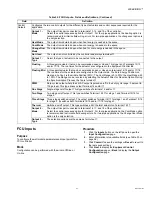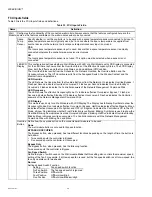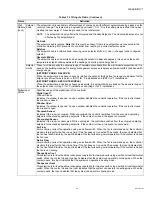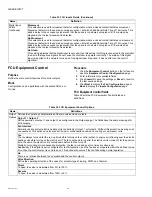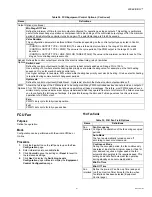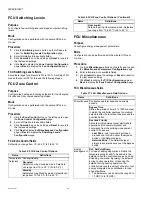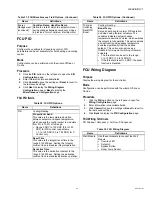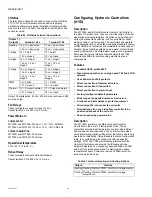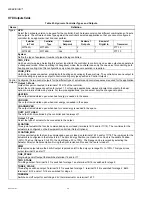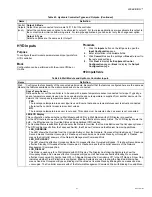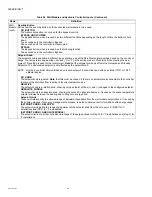
WEBVISION™
71
95-7769—01
HYD Miscellaneous Parameters
Purpose
To configure miscellaneous and energy management
parameters.
Mode
Configuration can be performed with the wizard Off-line or
On-line.
Procedure
1.
Click the
Miscellaneous
button on the left pane to open
the
Miscellaneous Configuration
page.
2.
Enter information into available fields.
3.
Click
Commit
to save the settings or
Reset
to revert to
the last saved settings.
4.
Click
Next
to display the
PID Configuration
page or
Back
to display the
Zone Control Configuration
page.
HYD Miscellaneous Parameter fields
HYD PID
Purpose
To configure the variables for closed loop control. PID
parameters can be set separately for both heating and cooling
control.
Mode
Configuration can be performed with the wizard Off-line or
On-line.
Procedure
1.
Click the
PID
button on the left pane to open the
PID
Configuration
page.
2.
Enter information into available fields (see Table 47 on
3.
Click
Commit
to save the settings or
Reset
to revert to
the last saved settings.
4.
Click
Next
to display the
Wiring Configuration
page or
Back
to display the
Miscellaneous Configuration
page.
HYD PID fields
Table 46. Hydronic Miscellaneous and Energy Management Parameters.
Name
Definition
Miscellaneous Configures operator bypass and priority options.
Bypass Time
Define the period of time (0 to 1080 minutes) in which the controller operates to occupied setpoints after the
local user has pressed the override button.
Override Priority
Allocate priority between local wall module operations (for example, Bypass) and commands from the building
management central. Choices are:
LAST WINS
– Last received input takes precedence. It can be either the Bypass button or the Network
signal.
NETWORK WINS
– The Network signal always takes precedence over the Bypass button.
Energy
Management
DLC Stpt Bump
For load shedding applications, define the temporary setpoint shift to be added to the setpoint when the
controller receives a Load Shedding command. By raising the setpoint during cooling operation, or reducing the
setpoint during heating operation, the controller reduces the amount of heat or cool energy dissipated as a
contribution to load shed algorithms. The parameter can be set in the range 0 to 10DDC (0 to 18DDF).
Cool Rec Ramp, Heat Rec Ramp
Define the rate at which the setpoint is reset during changes between occupancy modes to provide a form of
optimum start algorithm.
Table 47. Hydronic PID Parameters.
Name
Definition
PID
Cooling/Heating
Proportional band
This value is the temperature deviation between setpoint and space temperature, which causes the control
output to modulate from 0 to 100% of full range. The variable can be set in the range 2 to 100 DDC (3.6 DDF to
180 DDF), respectively; 1.3 to 100 DDC (2.3 DDF to 180 DDF) for P Control only.
Reset Time
This value is the integral reset time in the range 0 to 3200 sec. Setting the Integral constant to zero disables
integral operation.
Derivative Time
This value is the derivative constant in the range 0 to 3200 sec. Setting the derivative constant to zero disables
derivative operation.

